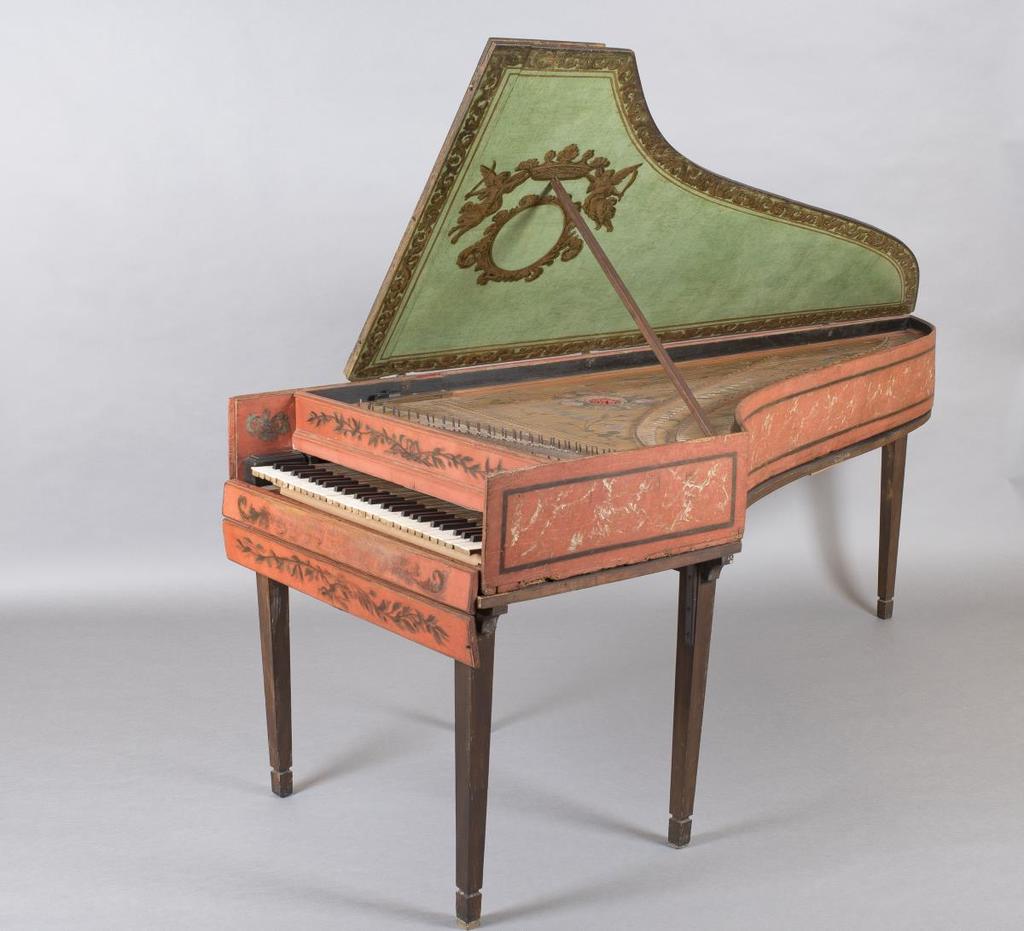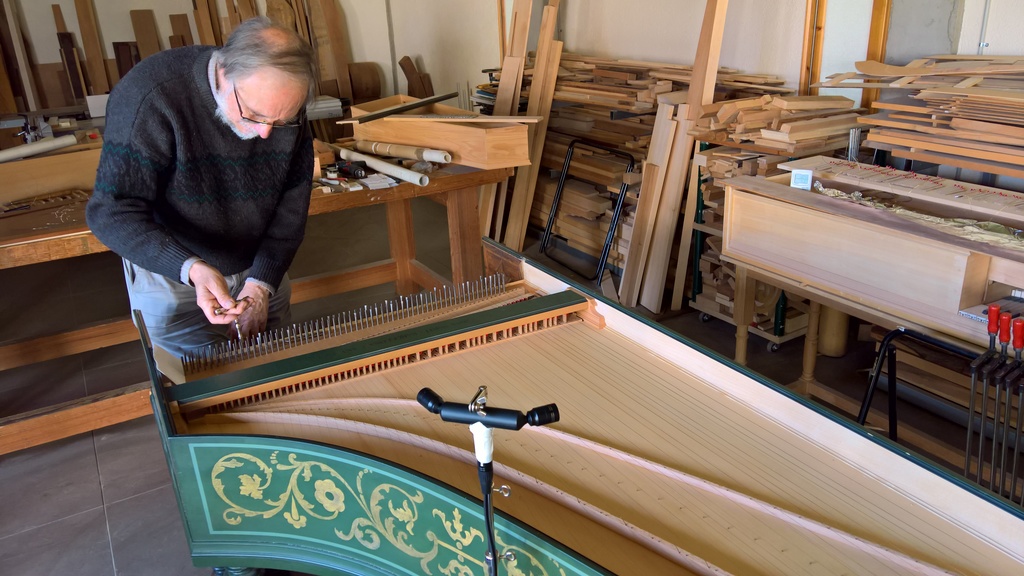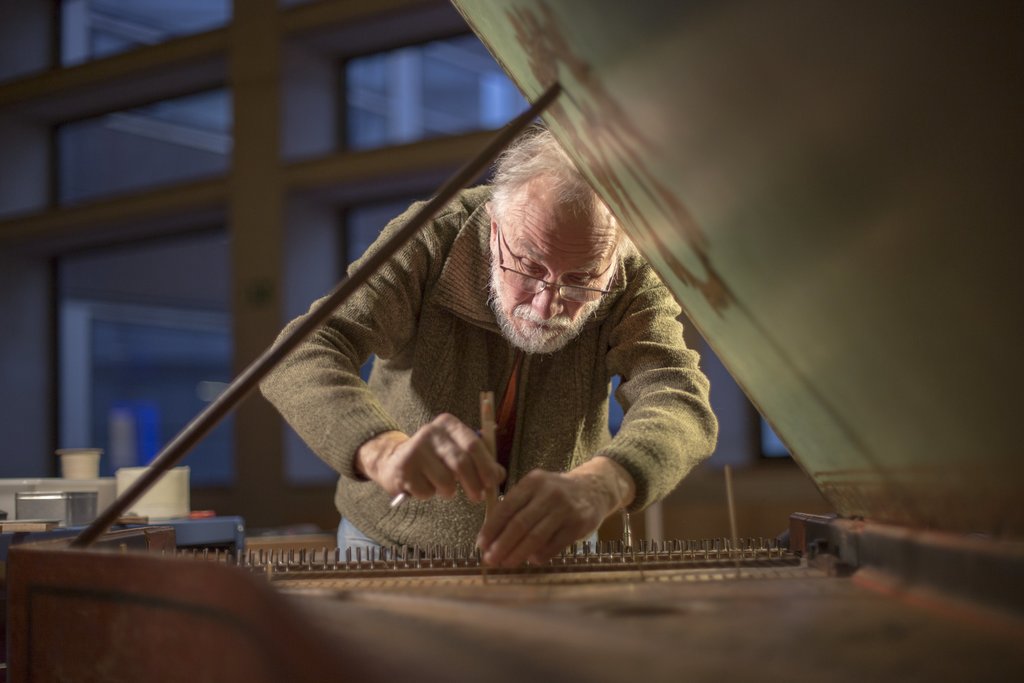
| Aquest clavicèmbal és una obra mestra de Carl Conrad Fleischer (1680-1721?), pertanyent a una important família de constructors de clavicèmbals establerts a Hamburg i actius entre els segles XVII i XVIII. Es conserven tres instruments seus, tots amb la roseta de pergamí característica de la família. La decoració és molt variada i complexa, amb motius florals, vegetals i animals. Prové de la col·lecció d'Orsina Baget de Folch, que es troba al Museu de la Música des dels seus inicis. L'instrument està restaurat estructuralment, però degut al seu disseny i antiguitat no podria resistir la tensió de les cordes. Així, tot i estar restaurat, no pot ni podrà mai sonar. Per això es va optar per una reconstrucció virtual: tensar i afinar totes les cordes, una per una, i enregistrar-les així, permetent al capdavall d'obtenir un joc de mostres complet. Hi ha però una qüestió evident: una corda d'un clavicèmbal no sona pas igual si és l'única tensada i afinada que si tota la resta també ho estan. Les altres cordes ressonen per simpatia, i la tensió sobre el cos de l'instrument també n'afecta el so. Per aquest motiu es va fer un treball previ sobre una reconstrucció d'un clavicèmbal Zell, sorgit del mateix taller que el Fleischer, enregistrant primer totes les notes d'una en una, amb la resta de les cordes destensades, i posteriorment, amb tot l'instrument afinat amb totes les cordes, per a obtenir un patró del canvi, patró que es va modelitzar informàticament i es va aplicar posteriorment a les mostres obtingudes del Fleischer del museu. | This harpsichord is a masterpiece by Carl Conrad Fleischer (1680-1721?), belonging to an important family of harpsichord builders established in Hamburg and active between the 17th and 18th centuries. Three of his instruments are preserved, all with the family's characteristic parchment rosette. The decoration is very varied and complex, with floral, plant and animal motifs. It comes from the collection of Orsina Baget de Folch, which has been in the Museu de la Música since its inception. The instrument has been structurally restored, but due to its design and age it could not withstand the tension of the strings. Thus, despite being restored, it cannot and will never be able to sound. For this reason, a virtual reconstruction was chosen: tensioning and tuning all the strings, one by one, and recording them in this way, ultimately allowing a complete set of samples to be obtained. There is, however, an obvious point: a harpsichord string does not sound the same if it is the only one tensioned and tuned as if all the others are also. The other strings resonate in sympathy, and the tension on the body of the instrument also affects its sound. For this reason, preliminary work was done on a reconstruction of a Zell harpsichord, which emerged from the same workshop as the Fleischer, first recording all the notes one by one, with the rest of the strings untensioned, and later, with the entire instrument tuned with all the strings, to obtain a pattern of change, a pattern that was modeled computer-aided and subsequently applied to the samples obtained from the Fleischer in the museum. |

|
L'instrument exposat al Museu de la Música de Barcelona està restaurat estructuralment, però degut al seu disseny i antiguitat no podria resistir la tensió de les cordes. Així, tot i estar restaurat, no pot ni podrà mai sonar.
Per això es va optar per una reconstrucció virtual: tensar i afinar totes les cordes, una per una, i enregistrar-les així, permetent al capdavall d'obtenir un joc de mostres complet.
Hi ha però una qüestió evident: una corda d'un clavicèmbal no sona pas igual si és l'única tensada i afinada que si tota la resta també ho estan. Les altres cordes ressonen per simpatia, i la tensió sobre el cos de l'instrument també n'afecta el so. Per aquest motiu es va fer un treball previ sobre una reconstrucció d'un clavicèmbal Zell, sorgit del mateix taller que el Fleischer, enregistrant primer totes les notes d'una en una, amb la resta de les cordes destensades, i posteriorment, amb tot l'instrument afinat amb totes les cordes, per a obtenir un patró del canvi, patró que es va modelitzar informàticament i es va aplicar posteriorment a les mostres obtingudes del Fleischer del museu. Foto d'aquest treball previ, anys abans d'abordar l'enregistrament definitiu: |
The instrument on display at the Museu de la Música in Barcelona has been structurally restored, but due to its design and age it could not withstand the tension of the strings. Thus, despite being restored, it cannot and will never be able to play.
That is why a virtual reconstruction was chosen: tensioning and tuning all the strings, one by one, and recording them in this way, ultimately allowing a complete set of samples to be obtained.
However, there is one obvious issue: a harpsichord string does not sound the same if it is the only one tensioned and tuned as if all the others are also. The other strings resonate in sympathy, and the tension on the body of the instrument also affects its sound. For this reason, preliminary work was done on a reconstruction of a Zell harpsichord, which came from the same workshop as the Fleischer, first recording all the notes one by one, with the rest of the strings unstrained, and later, with the entire instrument tuned with all the strings, to obtain a pattern of change, a pattern that was computer-modeled and later applied to the samples obtained from the Fleischer in the museum. Photo of this preliminary work, years before tackling the definitive recording: |

| Per a enregistrar les mostres va caldre tot un treball d'adaptació, gairebé individual per a cada nota, de les parts mecàniques, atès que l'instrument no es pot fer sonar normalment, tampoc no s'havien fet durant la restauració estructural els ajustos necessaris ni tampoc cap tipus d'harmonització, treball de totes totes impossible si l'instrument no es pot tocar. | To record the samples, a lot of work was needed to adapt the mechanical parts, almost individually for each note, since the instrument cannot be played normally, nor had the necessary adjustments been made during the structural restoration, nor any type of harmonization, work that is all but impossible if the instrument cannot be played. |
